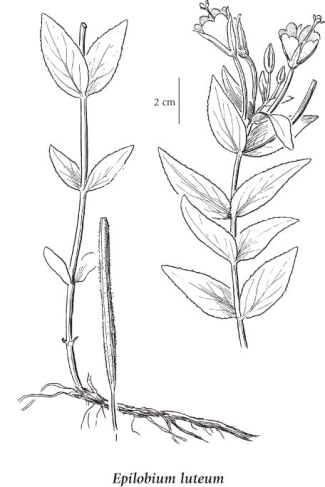Epilobium luteum Pursh
yellow willowherb
Onagraceae (Evening Primrose family)
Introduction to Vascular Plants
yellow willowherb
Onagraceae (Evening Primrose family)
Introduction to Vascular Plants
Species Information click to expand contents
General:
Perennial herb from widespread rhizomes, sometimes with basal winter bulblets, stolons short and leafy or compact; stems erect, 15-75 cm tall, simple or branched above, glabrous or short stiff-hairy in lines.
Leaves:
Mostly opposite, spoon- to egg-shaped, 2.5-8 cm long, 1.2-3.5 cm wide, glandular-toothed, sharp-pointed, glabrous except for the (usually) minutely-hairy margins and midrib; stalks 1-3 mm long.
Flowers:
Inflorescence of 2 to 10 flowers in upper leaf axils, nodding in bud, densely glandular and short stiff-hairy; hypanthium cup-shaped, 1.2-3 mm long; petals shallowly heart-shaped,12-22 mm long, yellow or cream, wavy-margined, notched at tip; sepals linear-lanceolate,10-12 mm long, densely glandular; anthers 2.2-3 mm long; ovaries 2-3.5 cm long, densely glandular; styles usually noticeably longer than petals; stigmas 4-lobed, the lobes 2 mm long, oblong egg-shaped.
Fruits:
Capsules, erect, linear, 4-8 cm long, glandular-hairy; stalks 10-22 mm long, glandular- and minutely-hairy; seeds 1-1.2 mm long, netted, tuft of hairs rust-colored, 6.5-8 mm long, persisting.
Notes:
Hybrids occur rarely between this species and others in BC. They resemble E. luteum with pink petals greater than 1 cm long. Hybrids between E. luteum and E. ciliatum ssp. glandulosum have been called E. x treleasianum Lev.
Illustration click to expand contents

If more than one illustration is available for a species (e.g., separate illustrations were provided for two subspecies) then links to the separate images will be provided below. Note that individual subspecies or varietal illustrations are not always available.
Illustration Source: The Illustrated Flora of British Columbia
Ecology click to expand contents
Ecological Framework for Epilobium luteum
The table below shows the species-specific information calculated from
original data (BEC database) provided by the BC Ministry of Forests and Range.
(Updated August, 2013)
The table below shows the species-specific information calculated from
original data (BEC database) provided by the BC Ministry of Forests and Range.
(Updated August, 2013)
| Site Information |
Value / Class |
||
|
Avg |
Min |
Max |
|
| Elevation
(metres) |
1448 | 747 | 1950 |
| Slope
Gradient (%) |
9 | 0 | 34 |
|
Aspect (degrees) |
279 | 12 | 335 |
| Soil
Moisture Regime (SMR) [0 - very xeric; 4 - mesic; 8 - hydric] |
6 | 3 | 8 |
| Modal
Nutrient Regime
Class |
C | ||
| #
of field plots species was recorded in: |
26 | ||
| Modal
BEC Zone Class |
ESSF | ||
|
All BEC Zones (# of stations/zone) species was recorded in |
BAFA(1), ESSF(13), ICH(1), IDF(2), MH(4), MS(3), SWB(1) | ||
|
Source:
Klinkenberg 2013
|
|||
Habitat and Range click to expand contents
Moist streambanks, springs, seepage areas, meadows and forest openings in the montane and subalpine zones; infrequent in S and W BC, rare northward; N to AK, E to SW AB and S to CA.
Status Information click to expand contents
Synonyms click to expand contents
Synonyms and Alternate Names:
Epilobium treleaseanum Levl. p.p.